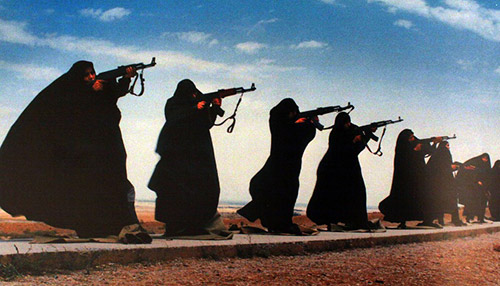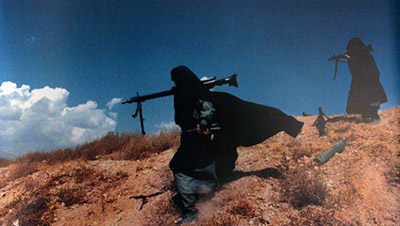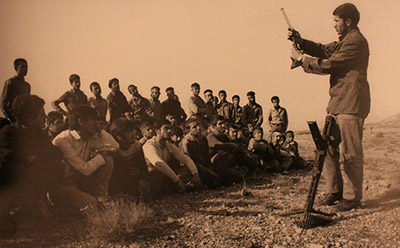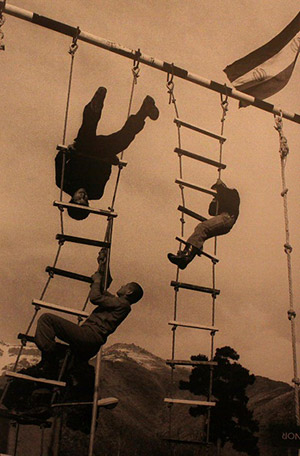Narrated by photos:
Military Training Course during Sacred Defense
Elham Saleh
Translated by: Fazel Shizard
2018-10-31
Amirali Javadian has started photography in Art Center since 1978. He went to the sacred defense's fronts in 1981 to photograph. At that time, he was the photographer- correspondent for News Agency of the Islamic Republic of Iran and continued until 1986. Javadian entered into the university after the years of imposed war by Saddam Hussein against the Islamic Republic of Iran, and received his doctoral degree from the collage of Fine Arts in 2004.
The photos chosen from the works of Amirali Javadian and will be shown below focus on military training during the sacred defense. At that time, the militant training of volunteers began from the mosques; they receive military training at the mosques and special places.

►Eight people; eight women. They want to shoot carefully. Here is rifle range, and women are being trained to shoot. Blue sky and white clouds show that it is a good weather for shooting. Each of them has a carpet piece underneath to kneel down, or even take some rest. They are ready to fight for Iran.
► Two persons; both of them have gun on shoulders. One who runs down a slope while both hands are full, and she is walking behind. Chitgar rifle range is the training place. They are wearing same uniform; grey or green mantle and both have tent, but they go down the slope quickly neglecting their clothes to be dirty in dust.

►All are young, but they are eager to defend the homeland. They must first receive training to be ready for fighting. They carefully look at what the trainer trains. These boys were only part of our groups who received military training by Bassij[1]

►Fighting is not just taking a weapon in hand; they should learn many things in Basij, such as crossing obstacles and heights. These three young people are also taking training course, while Iranian flag is fluttering in an airflow at the corner of the photo.

► A young girl who has come to receive military training to defend the country if needed. There is a sentence written on the wall behind him "The Islamic state must be military one." It is one of sentence of Imam Khomeini, dated Azar 1358 (December 1979).

► Ladies endure all the hardships of military training, just like these women (in the photo) who take guns in their hands and creeping. Both are staring at the ground as if they shrank from a look at the camera of the photographer, maybe they are still busy with training forgot his presence.

Source:
Permanent Frames 3: the Selection of sacred Defense's photos (photos by Amirali Javadian) / The Foundation for the Protection of Works and the Publishing of Sacred Defense Values
Number of Visits: 6716








The latest
- 100 Questions/7
- Managing Oral History Interviews
- The 372nd Night of Memories – Part 1
- Third Regiment: Memoirs of an Iraqi Prisoner of War Doctor – 7
- Objects Tell What Happened in the Eight-Year War!
- 100 Questions/6
- Comparative Analysis of Women’s and Men’s Written Memoirs in the Sacred Defense
- The Importance of Pre-Publication Critique of Oral History Works
Most visited
- Third Regiment: Memoirs of an Iraqi Prisoner of War Doctor – 6
- Comparative Analysis of Women’s and Men’s Written Memoirs in the Sacred Defense
- 100 Questions/6
- Third Regiment: Memoirs of an Iraqi Prisoner of War Doctor – 7
- Objects Tell What Happened in the Eight-Year War!
- The Importance of Pre-Publication Critique of Oral History Works
- The 372nd Night of Memories – Part 1
- Managing Oral History Interviews
Unveiling of the book "Oral History: What and Why"
The First report: Alireza KamariAccording to the Oral History website, the unveiling ceremony of the book "Oral History: What and Why" by Hamid Qazvini was held on Sunday evening, November 24, 1404, in the presence of experts in the field of oral history in the Salman Farsi Hall of the Arts Center.
Mohammad — The Messiah of Kurdistan
Boroujerdi immediately said to Darvish, “Ready a few men; we’re going.” Then he moved toward Mostafa, who was studying the Kurdistan map. Mostafa straightened his back and said, “During my service in the army I experienced a full-scale war in Kurdistan. Guerrilla warfare in Kurdistan follows its own rules. The anti-revolutionary commanders want to draw us into a battle chosen on their terms.”From Javanrud to Piranshahr
The Memoir of Reza MohammadiniaThe book From Javanrud to Piranshahr recounts the life and struggles of Commander Reza Mohammadinia, who spent part of the Iran–Iraq War in the western and northwestern regions of the country. During those years, he held responsibilities such as deputy commander of the Seventh Region of the Islamic Revolutionary Guard Corps (IRGC), acting head of the Javanrud district, service on the southern fronts, director of ...


